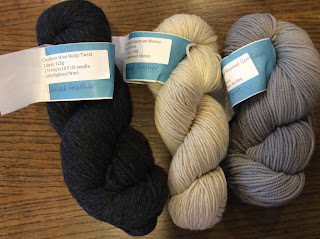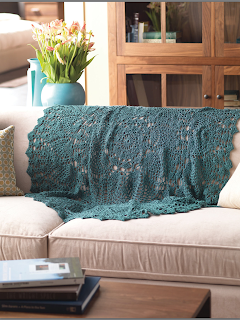When I look at a book, and think about adding it to my
Crochet books library, I have certain criteria that I look for in the book, and
it should meet most of these if I am going to add it. So when I was asked to review
this book, Crochet Cowls by Sharon Silverman, I thought I would look to see if
it met my criteria.
Here is what I look for:
1. Do I know the author? Or have I heard of the author?
In this case, yes, to both. I have heard of the author. And
I know the author, Sharon Silverman. I have several of her books, some I have
reviewed. I know how thorough she is with her instructions. I know how
knowledgeable she is, also. Years ago, when she was just starting out, she took
one of my classes at the Crochet Guild of America's Chain Link conference. It's difficult to remember everyone you meet at a conference, but I know that we've been corresponding
lately, and I feel that I know her. Disclaimer: whether I know the author or
not, that doesn't influence me when I review their work.
2. Who tech edited the book? Who did the charts? Do I know
or have I heard of them?
I am a tech editor, and I know how difficult it is to tech edit a book. In this
case, I couldn't find a name for the tech editor (it might have been listed as
"assistant editor"). But I did find a name for the person who did the
charts – Lindsey Stephens. I know her, and know that she does excellent work.
So I know the charts and stitch diagrams will be correct.
3.What about the skill levels? Are the designs for just one
skill level, or many different skill levels?
There are 15 designs in this book, and the skill levels are
divided between them – 4 Easy, 8 Intermediate, and 3 Experienced. So there is
something for everyone!
4. What about the yarn? What type of yarn is used?
Once again, Sharon thought of everyone's preferences for yarn. The yarn weights range from Lace weight (0), to Jumbo weight (7). In other words, the yarn weights are: lace, super fine, fine, light, medium (also known as worsted), bulky, super bulky, and jumbo. So whether you like working with Jumbo yarn, or Lace weight, or anything in between, you'll find at least one cowl you can crochet. And perhaps you'll also try a yarn weight that you don't usually use! It's a great opportunity to expand your skills!
4. What about the yarn? What type of yarn is used?
Once again, Sharon thought of everyone's preferences for yarn. The yarn weights range from Lace weight (0), to Jumbo weight (7). In other words, the yarn weights are: lace, super fine, fine, light, medium (also known as worsted), bulky, super bulky, and jumbo. So whether you like working with Jumbo yarn, or Lace weight, or anything in between, you'll find at least one cowl you can crochet. And perhaps you'll also try a yarn weight that you don't usually use! It's a great opportunity to expand your skills!
5. What about special stitches and techniques? Are there any? Do you have
to look in the back of the book for them, or are they included in the pattern
directions?
If a cowl uses special techniques or stitches, the
instructions, along with great pictures, are included with the directions. You
don’t' have to search for them!
6. Stitch diagrams? Are they included with each pattern?
Each of the 15 patterns has at least one stitch diagram that
shows a section of the pattern. That is my favorite part of any book. When I
see a pattern I like, I want to crochet a section of it first – to see if I can
follow the pattern, and to see if I like the way the stitches look in the yarn
that I want to use. So I always look for stitch diagrams, to help me with my
swatching. I use them to make gauge swatches, and to test new stitch patterns.
Sometimes (and this is why I love stitch diagrams) I just use the stitch
pattern, and crochet myself something else, not the original pattern that it came from! But
however I use them, I know that reading stitch diagrams is usually a lot easier than
reading patterns – long ones or short ones.
7. Anything else?
Yes!. In the back of the book, there is a section of the basic crochet stitches – with directions, and pictures. Just in case! Also, just in case, there is section on Tunisian Crochet (used in some of the patterns), and, some helpful hints for Tunisian Crochet. Then, there is information on how to read a pattern, and how to read a stitch chart or diagram - including Tunisian stitch diagrams. Then the usual stuff is included – abbreviations, hook sizes, what the crochet skill levels mean, and what the yarn categories mean.
Yes!. In the back of the book, there is a section of the basic crochet stitches – with directions, and pictures. Just in case! Also, just in case, there is section on Tunisian Crochet (used in some of the patterns), and, some helpful hints for Tunisian Crochet. Then, there is information on how to read a pattern, and how to read a stitch chart or diagram - including Tunisian stitch diagrams. Then the usual stuff is included – abbreviations, hook sizes, what the crochet skill levels mean, and what the yarn categories mean.
8. What else is included?
There are all sorts of different techniques you will learn if you crochet these cowls.
You can learn how to work beaded crochet, in Art Deco Skyline.
Or learn Mosaic Crochet, in Magenta Mosaic.
Pearly Grapes will teach you how to work Tunisian Knit and Purl stitches.
Intarsia Arrows will teach you how to work Tunisian Colorwork.
And there's so much more: Tunisian Double hook techniques, crochet through the back loop, Tunisian Full stitch, Loop stitch, etc.
So, all in all, Crochet Cowls is a very thorough book.
There are all sorts of different techniques you will learn if you crochet these cowls.
You can learn how to work beaded crochet, in Art Deco Skyline.
Or learn Mosaic Crochet, in Magenta Mosaic.
Pearly Grapes will teach you how to work Tunisian Knit and Purl stitches.
Intarsia Arrows will teach you how to work Tunisian Colorwork.
And there's so much more: Tunisian Double hook techniques, crochet through the back loop, Tunisian Full stitch, Loop stitch, etc.
So, all in all, Crochet Cowls is a very thorough book.
When I looked through the book, I saw 5 or 6 cowls that I
immediately wanted to make. Or at least try out their stitch patterns, because
they intrigued me. I found some yarn to work with and I got started.
The first one that intrigued me was the Maritime Chevrons.
I
love to crochet chevrons, and I like to use different techniques to make them.
I have two favorite techniques, to make the chevrons, but I never thought to put these techniques together. Sharon did, and I really like the way that looked. So I tried it, and this is what my swatch looks like:
I like the way the peaks are sharp, and the trough (Sharon's term) is not
overcrowded. I'm going to remember this technique.
Another cowl that I liked was the Loopy Boa.
I love to make
the loop stitch, and wanted to see how Sharon did it, because there are a
couple of ways to catch the strand or strands that make the loop. Sharon explained
her technique, and showed pictures of how she made them, and she does it just
like I do – which I think is the best way and the strongest way to crochet
them! (Of course!)
But what Sharon changed, and this was very clever, was the
row of stitches that goes between the rows of loop stitches. I found that what she did made the rows of loops seem a lot lighter and fluffier. And the crocheting went much faster. So this is another technique I will
have to remember!
Here's my swatch:
The Zigzag Pip Stitch Cowl stitch pattern was another one
that caught my eye.
First, I loved the way the colors changed in the cowl. And
two, the stitch pattern diagram was interesting, not too complicated, and I
thought it would be easy to remember. So, I tried the stitch pattern and I liked the swatch.
Also, it was an easy stitch pattern to remember. I didn't have to look back and
forth between my work and the directions. And the stitch diagram was very easy
to follow and understand.
Here's my swatch:
Then I swatched the neck part of the Firelight Tunic. Here's a picture of the tunic:
And here's a picture of my swatch:
I love the look of the ribbing, and how it was created.
The Double Strand Delight was next, but I used only one
strand to work my swatch. You'll learn how to work a large cluster with this
pattern.
Here's the cowl:
Finally, I was intrigued by Atlantic Ice, the cowl on the cover of the book. The stitch diagram
helped a lot, and I took Sharon's advice to crocheters who have not worked with
mohair before. (I have, but didn't have any handy.) She said to use one strand
of worsted weight yarn (the pattern uses two strands of lace weight mohair) to
practice to become famliar with the pattern before starting with the mohair. So
I used one strand of cotton yarn, and I was able to follow the stitch diagram
very easily. I discovered that the pattern is not that complicated. Try it,
you'll like it!
Here's the cowl:
So once again, Sharon's book meets my criteria for a great
crochet book that I want to have for my Crochet Book library. I know that there are many great stitch patterns in there, and even if I don't want to make a cowl, I can still use the stitch patterns. Plus, there are a lot of different techniques included. If you also want the book, you can order it from Amazon here:
Crochet Cowls
Crochet Cowls
Or, you can write a comment below. Tell me which cowl you
would like to crochet first, or which stitch pattern you would like to try, and leave your email address so I can get in touch with you (I won't publish that),
and in one week, Wednesday, October 5, I will pick one winner to receive a free copy of
Crochet Cowls - your choice - print or ebook.
Good luck!
Shanken Photography took the professional pictures. I took pictures of my swatches.








































